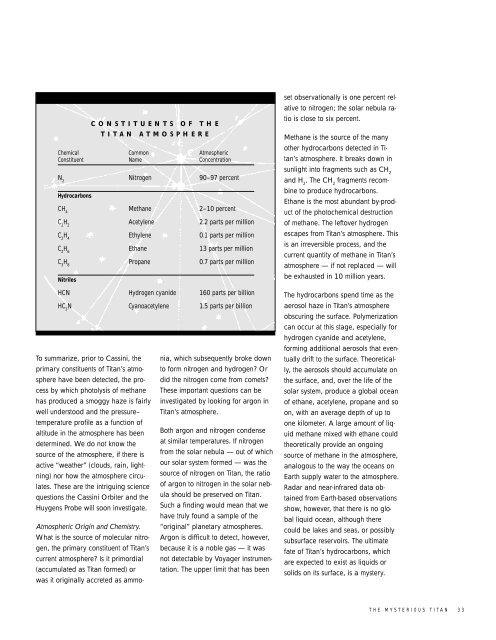Passage to a Ringed World - NASA's History Office
Passage to a Ringed World - NASA's History Office
Passage to a Ringed World - NASA's History Office
Create successful ePaper yourself
Turn your PDF publications into a flip-book with our unique Google optimized e-Paper software.
CONSTITUENTS OF THE<br />
TITAN ATMOSPHERE<br />
Chemical Common Atmospheric<br />
Constituent Name Concentration<br />
N 2 Nitrogen 90–97 percent<br />
Hydrocarbons<br />
CH 4 Methane 2–10 percent<br />
C 2 H 2 Acetylene 2.2 parts per million<br />
C 2 H 4 Ethylene 0.1 parts per million<br />
C 2 H 6 Ethane 13 parts per million<br />
C 3 H 8 Propane 0.7 parts per million<br />
Nitriles<br />
HCN Hydrogen cyanide 160 parts per billion<br />
HC 3 N Cyanoacetylene 1.5 parts per billion<br />
To summarize, prior <strong>to</strong> Cassini, the<br />
primary constituents of Titan’s atmosphere<br />
have been detected, the process<br />
by which pho<strong>to</strong>lysis of methane<br />
has produced a smoggy haze is fairly<br />
well unders<strong>to</strong>od and the pressure–<br />
temperature profile as a function of<br />
altitude in the atmosphere has been<br />
determined. We do not know the<br />
source of the atmosphere, if there is<br />
active “weather” (clouds, rain, lightning)<br />
nor how the atmosphere circulates.<br />
These are the intriguing science<br />
questions the Cassini Orbiter and the<br />
Huygens Probe will soon investigate.<br />
Atmospheric Origin and Chemistry.<br />
What is the source of molecular nitrogen,<br />
the primary constituent of Titan’s<br />
current atmosphere? Is it primordial<br />
(accumulated as Titan formed) or<br />
was it originally accreted as ammo-<br />
nia, which subsequently broke down<br />
<strong>to</strong> form nitrogen and hydrogen? Or<br />
did the nitrogen come from comets?<br />
These important questions can be<br />
investigated by looking for argon in<br />
Titan’s atmosphere.<br />
Both argon and nitrogen condense<br />
at similar temperatures. If nitrogen<br />
from the solar nebula — out of which<br />
our solar system formed — was the<br />
source of nitrogen on Titan, the ratio<br />
of argon <strong>to</strong> nitrogen in the solar nebula<br />
should be preserved on Titan.<br />
Such a finding would mean that we<br />
have truly found a sample of the<br />
“original” planetary atmospheres.<br />
Argon is difficult <strong>to</strong> detect, however,<br />
because it is a noble gas — it was<br />
not detectable by Voyager instrumentation.<br />
The upper limit that has been<br />
set observationally is one percent relative<br />
<strong>to</strong> nitrogen; the solar nebula ratio<br />
is close <strong>to</strong> six percent.<br />
Methane is the source of the many<br />
other hydrocarbons detected in Titan’s<br />
atmosphere. It breaks down in<br />
sunlight in<strong>to</strong> fragments such as CH2 and H . The CH fragments recom-<br />
2 2<br />
bine <strong>to</strong> produce hydrocarbons.<br />
Ethane is the most abundant by-product<br />
of the pho<strong>to</strong>chemical destruction<br />
of methane. The lef<strong>to</strong>ver hydrogen<br />
escapes from Titan’s atmosphere. This<br />
is an irreversible process, and the<br />
current quantity of methane in Titan’s<br />
atmosphere — if not replaced — will<br />
be exhausted in 10 million years.<br />
The hydrocarbons spend time as the<br />
aerosol haze in Titan’s atmosphere<br />
obscuring the surface. Polymerization<br />
can occur at this stage, especially for<br />
hydrogen cyanide and acetylene,<br />
forming additional aerosols that eventually<br />
drift <strong>to</strong> the surface. Theoretically,<br />
the aerosols should accumulate on<br />
the surface, and, over the life of the<br />
solar system, produce a global ocean<br />
of ethane, acetylene, propane and so<br />
on, with an average depth of up <strong>to</strong><br />
one kilometer. A large amount of liquid<br />
methane mixed with ethane could<br />
theoretically provide an ongoing<br />
source of methane in the atmosphere,<br />
analogous <strong>to</strong> the way the oceans on<br />
Earth supply water <strong>to</strong> the atmosphere.<br />
Radar and near-infrared data obtained<br />
from Earth-based observations<br />
show, however, that there is no global<br />
liquid ocean, although there<br />
could be lakes and seas, or possibly<br />
subsurface reservoirs. The ultimate<br />
fate of Titan’s hydrocarbons, which<br />
are expected <strong>to</strong> exist as liquids or<br />
solids on its surface, is a mystery.<br />
THE MYSTERIOUS TITAN 33
















